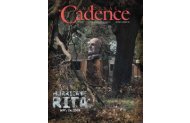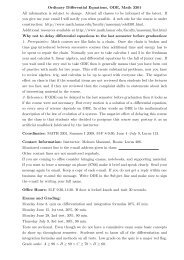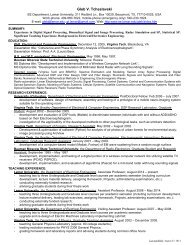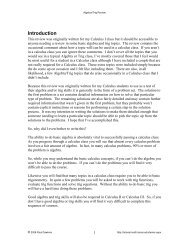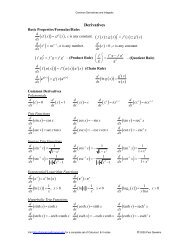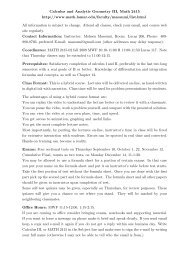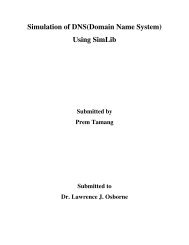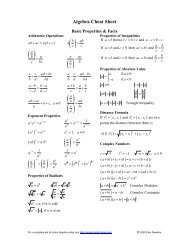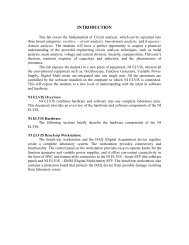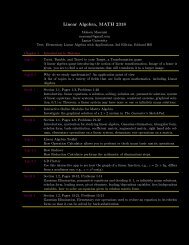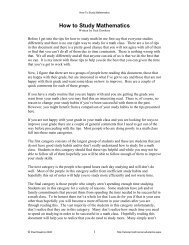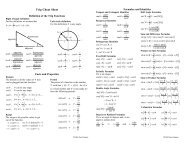TSI sample questions
TSI sample questions
TSI sample questions
- No tags were found...
You also want an ePaper? Increase the reach of your titles
YUMPU automatically turns print PDFs into web optimized ePapers that Google loves.
© 2013 The College Board. College Board, ACCUPLACER and the acorn logo are<br />
registered trademarks of the College Board. All other products and services may<br />
be trademarks of their respective owners. Visit the College Board on the Web:<br />
www.collegeboard.org.<br />
Texas Success Initiative<br />
Sample Questions
Mathematics<br />
The Texas Success Initiative (<strong>TSI</strong>) Mathematics<br />
and Statistics test contains <strong>questions</strong> that measure<br />
proficiency in four content areas. The four content<br />
areas are as follows:<br />
Elementary Algebra and Functions — Topics<br />
covered in this category include:<br />
• Linear equations, inequalities and systems<br />
• Algebraic expressions and equations<br />
• Word problems and applications<br />
Intermediate Algebra and Functions — Topics<br />
covered in this category include:<br />
• Quadratic and other polynomial expressions,<br />
equations and functions<br />
• Expressions, equations and functions involving<br />
powers, roots and radicals<br />
• Rational and exponential expressions, equations<br />
and functions<br />
Geometry and Measurement — Topics covered in<br />
this category include:<br />
• Plane geometry<br />
• Transformations and symmetry<br />
• Linear, area and three-dimensional measurements<br />
Mathematics Sample Questions<br />
Directions for <strong>questions</strong> 1–15<br />
For each of the <strong>questions</strong> below, choose the best<br />
answer from the four choices given. You may use the<br />
paper you received as scratch paper.<br />
1. If 3t− 7= 5, t then 6t =<br />
A. 21<br />
B. −7<br />
C. −21<br />
D. −42<br />
2. The variables x and y are directly proportional, and y = 2<br />
when x = 3. What is the value of y when x = 9<br />
A. 4<br />
B. 6<br />
C. 8<br />
D. 12<br />
y<br />
C<br />
Data Analysis, Statistics and Probability — Topics<br />
covered in this category include:<br />
• Interpreting categorical and quantitative data<br />
• Statistical measures<br />
• Probabilistic reasoning<br />
O<br />
x<br />
3. In the xy -plane above, point C has coordinates (6, 9).<br />
Which of the following is an equation of the line that<br />
contains points O and C <br />
A. y = x−<br />
3<br />
B. y = x+<br />
3<br />
C.<br />
D.<br />
2<br />
y = x<br />
3<br />
3<br />
y = x<br />
2<br />
© 2013 The College Board. Diagnostic and Placement Test Sample Questions<br />
1
4. There are 3x − 2 trees planted in each row of a rectangular<br />
parcel of land. If there are a total of 24x − 16 trees planted<br />
in the parcel, how many rows of trees are there in the parcel<br />
A. 21x −18<br />
B. 21x −14<br />
C. 8x<br />
D. 8<br />
9.<br />
2 3 3<br />
(3 xy ) =<br />
A.<br />
B.<br />
C.<br />
D.<br />
5 6<br />
3x y<br />
6 9<br />
9x y<br />
5 6<br />
27x y<br />
6 9<br />
27x y<br />
5. A group of 18 people ordered soup and sandwiches for<br />
lunch. Each person in the group had either one soup or one<br />
sandwich. The sandwiches cost $7.75 each and the soups<br />
cost $4.50 each. If the total cost of all 18 lunches was<br />
$113.50, how many sandwiches were ordered<br />
A. 7<br />
B.<br />
C. 9<br />
D. 10<br />
6. Which of the following equations has both 1 and − 3 as<br />
solutions<br />
A.<br />
B.<br />
C.<br />
D.<br />
2<br />
x −2x− 3=<br />
0<br />
2<br />
x + 2x− 3=<br />
0<br />
2<br />
x − 4x+ 3=<br />
0<br />
2<br />
x + 4x+ 3=<br />
0<br />
7. In the xy -plane, what is the y -intercept of the graph of the<br />
equation y = 2( x+ 3)( x−<br />
4)<br />
A. −24<br />
B. −12<br />
C. −2<br />
D. 12<br />
10. If 5− x = 4, then x =<br />
A. −21<br />
B. −11<br />
C. 1<br />
D. 11<br />
11. If<br />
x − 1 = 20, then x =<br />
x<br />
A. −21<br />
B. −19<br />
C.<br />
D.<br />
1<br />
−<br />
19<br />
1<br />
21<br />
12. A ball was kicked into the air from a balcony 20 feet<br />
above the ground, and the ball’s height above the<br />
ground, in feet, t seconds after the ball was kicked was<br />
ht ( ) = 20 − 16t + 32 t.<br />
What was the maximum height, in<br />
feet, of the ball above the ground after it was kicked<br />
A. 32<br />
B. 34<br />
C. 36<br />
D. 40<br />
8.<br />
4<br />
x − 1 =<br />
A.<br />
B.<br />
C.<br />
D.<br />
2<br />
( x+ 1)( x− 1)( x + 1)<br />
( x+ 1) ( x−1)<br />
2 2<br />
( x+ 1) ( x−1)<br />
4<br />
( x −1)<br />
3 1<br />
13. The yard behind the Cindy’s house is rectangular in shape<br />
and has a perimeter of 72 feet. If the length of the yard<br />
is 18 feet longer than the width w of the yard, what is the<br />
area of the yard, in square feet<br />
A. 36<br />
B. 144<br />
C. 243<br />
D. 486<br />
© 2013 The College Board. Diagnostic and Placement Test Sample Questions<br />
2
City<br />
A<br />
B<br />
C<br />
D<br />
E<br />
High<br />
Temperature<br />
t°F<br />
87°F<br />
81°F<br />
62°F<br />
93°F<br />
14. The table above shows the high temperature last Thursday<br />
for five cities, A through E . If the median of the Thursday<br />
high temperatures for these cities was 81° F, which of the<br />
following could NOT have been the high temperature last<br />
Thursday for City A <br />
A. 85°<br />
F<br />
B. 75°<br />
F<br />
C. 65°<br />
F<br />
D. 55°<br />
F<br />
15. There are 20 children in the cast of a class play, and 8 of the<br />
children are boys. Of the boys, 4 have a speaking part in the<br />
play, and of the girls, 8 do not have a speaking part in the<br />
play. If a child from the cast of the play is chosen at random,<br />
what is the probability that the child has a speaking part<br />
A.<br />
B.<br />
C.<br />
D.<br />
2<br />
5<br />
1<br />
2<br />
3<br />
5<br />
3<br />
4<br />
© 2013 The College Board. Diagnostic and Placement Test Sample Questions<br />
3
Reading<br />
The Texas Success Initiative (<strong>TSI</strong>) Reading test<br />
contains <strong>questions</strong> that measure proficiency in four<br />
content areas. The four content areas are as follows:<br />
Literary Analysis — Topics covered in this category<br />
include:<br />
• Identifying and analyzing ideas in and elements of<br />
literary texts<br />
Main Idea and Supporting Details — Topics covered<br />
in this category include:<br />
• Identifying the main idea of a passage<br />
• Comprehending explicit textual information in a<br />
passage<br />
Inferences in a Text or Texts — Topics covered in this<br />
category include:<br />
• Synthesizing ideas by making a connection or<br />
comparison between two passages<br />
• Making an appropriate inference about single<br />
passages<br />
Author’s Use of Language — Topics covered in this<br />
category include:<br />
• Identifying an author’s purpose, tone and<br />
organization or rhetorical strategies and use of<br />
evidence<br />
• Determining the meaning of words in context<br />
Reading Sample Questions<br />
Directions for <strong>questions</strong> 1–9<br />
Read the passage and then choose the best answer to the<br />
question. Answer the question on the basis of what is<br />
stated or implied in the passage.<br />
1. When we think of volcanoes, eruptions, lava, and smokefilled<br />
air come to mind—all occurring on land. Most people<br />
are surprised to learn about the prevalence of underwater<br />
volcanoes on our planet. Because the lava and smoke spilling<br />
out of an active, underwater volcano is contained by the<br />
ocean, people generally do not take note of these eruptions.<br />
However, the largest underwater volcanoes are capable of<br />
creating huge tidal waves, threatening coastal communities.<br />
The main idea of the passage is that<br />
A. traditional volcanoes and underwater volcanoes are<br />
similar<br />
B. the lava and smoke from an underwater volcano is<br />
contained by the sea<br />
C. most tidal waves are caused by underwater volcanoes<br />
D. underwater volcanoes receive little attention but can be<br />
dangerous<br />
2. In 2010, talk show host Oprah Winfrey and novelist<br />
Jonathan Franzen kissed and made up after a nine-year<br />
feud. In 2001, Franzen was disinvited from appearing on<br />
Winfrey’s TV show to pitch his novel The Corrections after<br />
he made it clear that he was unhappy about the book’s being<br />
chosen for the Oprah Book Club. Describing his work as<br />
“in the high-art literary tradition,” Franzen said he didn’t<br />
want to be associated with the Club, which he accused of<br />
occasionally choosing “schmaltzy, one-dimensional” novels.<br />
But Winfrey is apparently able to forgive and forget: she<br />
chose Franzen’s next novel, Freedom, for her book club and<br />
said of it, “Now you haven’t heard me say this word often,<br />
but this book is a masterpiece.”<br />
The passage implies that Franzen’s criticism of the Oprah<br />
Book Club was motivated primarily by<br />
A. pride<br />
B. anger<br />
C. insensitivity<br />
D. ignorance<br />
© 2013 The College Board. Diagnostic and Placement Test Sample Questions<br />
4
3. The main authors of The Declaration of Independence<br />
and the Constitution are usually thought of as America’s<br />
“Founding Fathers.” Other, less known personages also<br />
deserve the title, however, and Noah Webster was one<br />
of these. Through his writings, which include the stillinfluential<br />
dictionary that bears his name, Webster sought<br />
to legitimize an “American English” that was independent<br />
of British spelling and pronunciation. For instance, Webster<br />
removed the “u” from “colour,” creating the distinct<br />
American version of the word.<br />
What is the main purpose of this passage<br />
A. To praise the Founding Fathers<br />
B. To present information about an important American<br />
C. To define and explain “American English”<br />
D. To distinguish American dictionaries from British<br />
dictionaries<br />
6. Television has been the primary source of information and<br />
entertainment for most Americans over the last 50 years.<br />
However, with Internet use on the rise year after year, some<br />
may wonder if surfing the net will soon surpass watching<br />
television as Americans’ primary leisure activity. Indeed,<br />
some recent surveys show that time spent on the Internet<br />
is now greater than time spent in front of the television.<br />
However, this statistic may not tell the whole story, as 59%<br />
of Americans say they multitask, using the Internet and<br />
watching TV simultaneously.<br />
The main idea of the passage is that television<br />
A. is only one of many information sources<br />
B. may have become less popular than the Internet<br />
C. is watched by more people now than ever before<br />
D. focuses more on entertainment than on news<br />
4. If you are committed to healthy, green living and want to<br />
reduce your environmental footprint, you might consider<br />
expanding your daily diet to include bugs. Supporters of the<br />
edible insect initiative rightfully argue that farming insects<br />
has a much lower environmental impact than does raising<br />
livestock since bugs are easier to harvest and require a<br />
fraction of the water and land space that cattle need. Indeed,<br />
the high-protein, low-fat health benefits of bug-eating have<br />
long been known. For hundreds of years, crickets, silkworms<br />
and even tarantulas have been served roasted, stewed and<br />
fried at the dinner tables of many cultures.<br />
Which words best describe the author’s attitude toward the<br />
“edible insect initiative”<br />
A. awe and amazement<br />
B. interest and support<br />
C. disgust and distaste<br />
D. fear and apprehension<br />
5. Long thought to be a case of mistaken identity, the discovery<br />
of the Bornean rainbow toad by European explorers in 1924<br />
was recently verified by scientists. The explorers had made a<br />
black-and-white sketch of an unusual toad they had found<br />
in the jungles of Southeast Asia, christening it the Bornean<br />
rainbow toad. Skeptical but curious, scientists recently went<br />
to look for the toad—and ended up finding three specimens.<br />
The passage implies which of the following about the<br />
Bornean rainbow toad<br />
A. Some people doubted the existence of the toad.<br />
B. Scientists were confident that they would find the toad.<br />
C. The surviving toads have been relocated to Europe.<br />
D. No human being had seen the toad since 1924.<br />
7. Plywood, while not the most pleasing wood to look at, has<br />
become an incredibly important building material in house<br />
construction. It is flexible, inexpensive, and strong. Its<br />
strength is due to layers of thin wood glued on top of each<br />
other with the grain of each layer making a right angle with<br />
the grain of the layer below it. This way of layering the sheets<br />
of wood makes plywood difficult to break.<br />
According to the passage, the arrangement of the layers of<br />
thin wood explains plywood’s<br />
A. strength<br />
B. cost<br />
C. attractiveness<br />
D. flexibility<br />
8. The 1922 German Expressionist film Nosferatu, directed by<br />
F. W. Murnau, is considered one of the most influential films<br />
in cinematic history—while also being a classic vampire<br />
movie. The film is closely based on Bram Stoker’s 1897 novel,<br />
Dracula; however, the villain in the film is called “Count<br />
Orlok” rather than “Count Dracula.” The reason is that<br />
the small studio that produced the film, Prana Film, was<br />
unable to secure the rights to Stoker’s novel. In fact, shortly<br />
after finishing Nosferatu, its one and only film, Prana went<br />
bankrupt in order to dodge copyright lawsuits from Stoker’s<br />
widow.<br />
Why does the author say that the vampire in Nosferatu is<br />
named “Count Orlok” and not “Count Dracula”<br />
A. To show that the makers of Nosferatu made minor<br />
changes to Stoker’s novel<br />
B. To suggest that the characters in Nosferatu were based<br />
on real people instead of literary characters<br />
C. To criticize Nosferatu for its differences from its source<br />
D. To praise the makers of Nosferatu for their imagination<br />
in recreating Stoker’s novel<br />
© 2013 The College Board. Diagnostic and Placement Test Sample Questions<br />
5
9. Guillermo Gonzalez Camarena became a successful inventor<br />
at an early age. By the age of seven, he had constructed a<br />
variety of electronically-propelled toys to play with; he later<br />
designed and built his own amateur radio and a functioning<br />
telescope. In 1940, when he was only 23, Camarena obtained<br />
the world’s first patent for color television. Camarena’s early<br />
color television transmission system was the first one to be<br />
approved by the U.S. Federal Communications Commission.<br />
Other color-television technologies came after Camarena’s<br />
patented invention, but his system is still used by a number<br />
of scientists today.<br />
In sentence 2, the word “functioning” most nearly means<br />
A. performing<br />
B. running<br />
C. working<br />
D. moving<br />
Directions for <strong>questions</strong> 10–11<br />
Read the 2 passages below and then choose the best<br />
answer to each question. Answer the <strong>questions</strong> on the<br />
basis of what is stated or implied in the passages.<br />
Passage 1<br />
I recently met a fifth-grade teacher who had asked her<br />
students what they did after school. Most said they stayed<br />
inside and watched TV or spent time on the computer.<br />
Some went to a recreation center for an afterschool<br />
program—where they played computer games. A handful<br />
of students played outside, but most of those were doing<br />
organized sports. It turned out that fewer than 10% of the<br />
children were enjoying unstructured time outside rather<br />
than concentrating on electronic devices. This is a tragedy!<br />
Now more than ever, kids need opportunities to learn<br />
and develop through outdoor activities—and not just on<br />
organized teams. Parents, limit computer use and encourage<br />
your kids to get outside and play every day!<br />
Passage 2<br />
There is almost no reliable data about the level of<br />
technological literacy among children in the United States.<br />
Our students perform relatively poorly on international<br />
tests in science and math, however, and many other Western<br />
countries teach more about technology than we do. It seems<br />
that American students are not as technologically literate<br />
as their international counterparts. This could put them<br />
at a disadvantage when it comes to their careers, because<br />
technology is everywhere, from medical facilities to farms.<br />
Obviously, it is imperative that teachers and parents make<br />
the use of technology, including computers, a more central<br />
part of children’s lives.<br />
10. The author of Passage 2 probably would respond to the last<br />
sentence of Passage 1 (“Parents . . . every day!”) by<br />
A. asserting that parents should help children find a<br />
balance of indoor and outdoor activities<br />
B. claiming that young children often know more about<br />
computers than their parents do<br />
C. pointing out that many children would rather use<br />
technology than play outside<br />
D. arguing that children should be spending more time<br />
using computers<br />
11. The author of Passage 1 would most likely criticize the<br />
author of Passage 2 for<br />
A. overemphasizing the strength of the data about<br />
students’ technological literacy<br />
B. overlooking the drawbacks of increasing the time<br />
children spend using technology<br />
C. dismissing as unimportant the development that<br />
occurs during outdoor activities<br />
D. exaggerating the proportion of careers that require<br />
knowledge of science and math<br />
Directions for <strong>questions</strong> 12–15<br />
Read the passage below and then choose the best answer<br />
to each question. Answer the <strong>questions</strong> on the basis of<br />
what is stated or implied in the passage.<br />
The narrator of this passage from a short story describes the<br />
cabin where her father worked.<br />
I wasn’t sure what this work involved, but it must have been<br />
exciting because the Lab itself was exciting. Anywhere we<br />
didn’t go often was exciting.<br />
We would get there in a heavy wooden rowboat, built in the<br />
five-house village half a mile away—our mother would row,<br />
she was quite good at it—or by following a twisty, winding<br />
footpath, over fallen trees and stumps and around boulders<br />
and across wet patches where a few slippery planks were laid<br />
across the sphagnum moss, breathing in the mildew smell<br />
of damp wood and slowly decaying leaves. It was too far for<br />
us to walk, our legs were too short, so mostly we went in the<br />
rowboat.<br />
The Lab was made of logs; it seemed enormous, though in<br />
the two photographs of it that survive it looks like a shack. It<br />
did however have a screened porch, with log railings. Inside<br />
it there were things we weren’t allowed to touch—bottles<br />
containing a dangerous liquid in which white grubs floated,<br />
their six tiny front legs clasped together like praying fingers,<br />
and corks that smelled like poison and were poison, and<br />
trays with dried insects pinned to them with long, thin pins,<br />
© 2013 The College Board. Diagnostic and Placement Test Sample Questions<br />
6
each with a tiny, alluring black knob for a head. All of this<br />
was so forbidden it made us dizzy.<br />
At the Lab we could hide in the ice house, a dim and<br />
mysterious place that was always bigger on the inside than<br />
it was on the outside, and where there was a hush, and a lot<br />
of sawdust to keep the blocks of ice cool. Sometimes there<br />
would be a tin of evaporated milk with holes punched in the<br />
top and wax paper stuck over them; sometimes there would<br />
be a carefully hoarded stub of butter or an end of bacon;<br />
sometimes there would be a fish or two, pickerel or lake<br />
trout, already filleted, laid out on a chipped enamel pie plate.<br />
What did we do in there There was nothing to actually do.<br />
We’d pretend we had vanished—that nobody knew where<br />
we were. This in itself was strangely energizing. Then we’d<br />
come out, away from the silence, back into the pine-needle<br />
scent and the sound of waves plocking against the shore, and<br />
our mother’s voice calling us, because it was time to get back<br />
into the rowboat and row home.<br />
12. In line 1, “this work” clearly refers to<br />
A. writing<br />
B. food science<br />
C. photography<br />
D. insect research<br />
13. Details in the passage suggest that the narrator is<br />
A. an adult remembering a recent incident<br />
B. an elderly person remembering middle age<br />
C. an adult recalling a location from childhood<br />
D. a child describing a frightening place<br />
14. The descriptions of the Lab and of the ice house are similar<br />
in that both descriptions<br />
A. emphasize cheerful and light-filled surroundings<br />
B. contain images of hiding and concealment<br />
C. highlight the narrator’s misconception of size<br />
D. contrast with descriptions of the narrator’s home<br />
15. When the narrator repeatedly uses the pronouns “we” and<br />
“us,” she is most likely speaking of herself and<br />
A. a sibling<br />
B. her mother<br />
C. her father<br />
D. the reader<br />
© 2013 The College Board. Diagnostic and Placement Test Sample Questions<br />
7
Writing<br />
The Texas Success Initiative (<strong>TSI</strong>) Writing test<br />
contains <strong>questions</strong> that measure proficiency in four<br />
content areas. The four content areas are as follows:<br />
Essay Revision — Topics covered in this category<br />
include:<br />
• Coherence, organization and word choice.<br />
• Rhetorical effectiveness and use of evidence<br />
Agreement — Topics covered in this category include:<br />
• Subject-verb agreement<br />
• Pronoun agreement<br />
• Verb tense<br />
Sentence Structure — Topics covered in this category<br />
include:<br />
• Comma splices and run-on sentences<br />
• Improper punctuation<br />
• Fragments and parallelism<br />
• Subordination and coordination<br />
Sentence Logic — Topics covered in this category<br />
include:<br />
• Correct placement of modifying phrase and<br />
clauses<br />
• The use of logical transitions<br />
Writing Sample Questions<br />
Directions for <strong>questions</strong> 1–5<br />
Read the following early draft of an essay and then<br />
choose the best answer to the question or the best<br />
completion of the statement.<br />
(1) Seaweed-based fuel could one day power your car. (2)<br />
It is more than just an ingredient in a purifying face mask<br />
or a sushi roll. (3) According to new research, seaweed has<br />
the potential to become an advanced biofuel known as<br />
biobutanol.<br />
(4) In the past, U.S. scientists have looked to the possibility<br />
of algae-based biofuels, but most of these explorations have<br />
shied away from kelp and seaweed. (5) One reason why<br />
seaweed may not have taken off as a potential fuel source<br />
is the fact that it’s not a major part of American culture.<br />
(6) In contrast, in Asian countries such as Japan, there has<br />
been a long history of seaweed in the cuisine. (7) Japanese<br />
researchers are much more familiar with it and have spent<br />
decades studying its potential uses.<br />
(8) A second reason for the U.S. avoidance of seaweedbased<br />
biofuel is the country’s lack of experience with<br />
seaweed farming. (9) The U.S. is no stranger to seaweed<br />
harvesting. (10) However, for the biobutanol project to be<br />
environmentally sustainable, seaweed cannot be harvested;<br />
it must be farmed. (11) “One of the challenges of harvesting<br />
a natural seaweed bed is you can only [use] a certain percent<br />
of the bed if you don’t want to have a negative environmental<br />
impact,” Nikesh Parekh, CEO of Bio Architecture Lab, said.<br />
(12) Farming enough seaweed to support mass production of<br />
a biofuel would be very expensive initially, but it could pay<br />
off handsomely. (13) They say that the seaweed-based fuel<br />
would work better in automobiles than ethanol and be easier<br />
to transport.<br />
1. In context, which of the following is the best way to revise<br />
and combine sentences 1 and 2 (reproduced below)<br />
Seaweed-based fuel could one day power your car. It is more<br />
than just an ingredient in a purifying face mask or a sushi roll.<br />
A. Seaweed-based fuel could one day power your car, it is<br />
more than just an ingredient in a purifying face mask<br />
or a sushi roll.<br />
B. Seaweed-based fuel could one day power your car<br />
because it is more than just an ingredient in a purifying<br />
face mask or a sushi roll.<br />
C. Seaweed is more than just an ingredient in a purifying<br />
face mask or a sushi roll; seaweed-based fuel could one<br />
day power your car.<br />
D. Fuel from seaweed could one day power your car so it is<br />
more than just an ingredient in a purifying face mask<br />
or sushi roll.<br />
© 2013 The College Board. Diagnostic and Placement Test Sample Questions<br />
8
2. In context, where would the following sentence best be<br />
placed<br />
There are a number of possible reasons for this.<br />
A. After sentence 2<br />
B. After sentence 4<br />
C. After sentence 6<br />
D. After sentence 9<br />
3. In context, which of the following is best to insert at the<br />
beginning of sentence 7 (reproduced below)<br />
Japanese researchers are much more familiar with it and have<br />
spent decades studying its potential uses.<br />
A. As a result,<br />
B. Ironically,<br />
C. However,<br />
D. In addition,<br />
Directions for <strong>questions</strong> 6–10<br />
Select the best version of the underlined part of the<br />
sentence. If you think the original sentence is best,<br />
choose the first answer.<br />
6. It is important to learn how to swim, even if one is afraid;<br />
the skill will invariably prove useful later in your life.<br />
A. one is<br />
B. you are<br />
C. everyone is<br />
D. they are<br />
7. In the Roman Empire, the first fish to be brought indoors<br />
was the sea barbel, it was kept under guest beds in small<br />
tanks made of marble.<br />
A. sea barbel, it<br />
B. sea barbel, which<br />
C. sea barbel, but<br />
D. sea barbel and<br />
4. In context, which of the following sentences would best be<br />
inserted between sentences 9 and 10<br />
Japanese researchers are much more familiar with it and have<br />
spent decades studying its potential uses.<br />
A. New research shows that seaweed may also possess the<br />
power to repair tissue damage in heart attack patients.<br />
B. Planting a large-scale seaweed farm will likely meet<br />
with stiff opposition.<br />
C. Maine Seaweed Co., for instance, harvests the seaweed<br />
naturally available along the U.S. coast.<br />
D. Some say that seaweed-based fuel may one day be competitive<br />
with petroleum.<br />
5. In context, which is the best revision to sentence 13<br />
(reproduced below)<br />
They say that the seaweed-based fuel would work better in<br />
automobiles than ethanol and be easier to transport.<br />
A. Replace “They say” with “Advocates contend”.<br />
B. Replace “would work” with “would be”.<br />
C. Delete “and be easier to transport”.<br />
D. Insert “their” before “automobiles”.<br />
8. The idea that lightning never strikes the same place twice<br />
is one of the oldest and most well-known weather-related<br />
myths; in fact, lightning strikes the Empire State Building in<br />
New York City about 100 times per year.<br />
A. in fact<br />
B. therefore<br />
C. moreover<br />
D. in contrast<br />
9. Horror films that keep viewers in a state of endless fright<br />
and which draw record-breaking crowds.<br />
A. that keep viewers in a state of endless fright and which<br />
draw<br />
B. keep viewers in a state of endless fright and drawing<br />
C. that keep viewers in a state of endless fright draw<br />
D. that keep viewers in a state of endless fright and they<br />
draw<br />
10. According to explorers, a "Lost Falls" resembling New York's<br />
Niagara Falls have been found in Tsangpo River Gorge in<br />
the Himalaya Mountains.<br />
A. have been found<br />
B. has been found<br />
C. having been found<br />
D. being found<br />
© 2013 The College Board. Diagnostic and Placement Test Sample Questions<br />
9
Directions for <strong>questions</strong> 11–15<br />
Think about how you would rewrite the following<br />
sentence according to the directions given, and then<br />
choose the best answer. Keep in mind that your revision<br />
should not change the meaning of the original sentence.<br />
11. In some places, the subsoils must sustain the crops because<br />
virtually all the topsoil has washed away.<br />
Rewrite, beginning with<br />
In some places, the subsoils must sustain the crops …<br />
The next word will be<br />
A. although<br />
B. because<br />
C. until<br />
D. before<br />
12. Hawaii, which consists of eight major islands and many<br />
smaller ones, and which used to be known as the Sandwich<br />
Islands, was admitted to the Union as the fiftieth state in<br />
1959.<br />
Rewrite, beginning with<br />
14. Carmen created a new piñata by constructing a papier-mâché<br />
figure and decorating it with brilliantly colored tissue paper.<br />
Rewrite, beginning with<br />
To create a new piñata, …<br />
The next words will be<br />
A. Carmen constructed a papier-mâché figure<br />
B. Carmen, constructing a papier-mâché figure<br />
C. a papier-mâché figure that Carmen had to construct<br />
D. that Carmen would construct a papier-mâché figure for<br />
15. If Antarctica’s icebergs could be floated north before<br />
melting, many arid areas would experience relief from<br />
drought.<br />
Rewrite, beginning with<br />
If they could be floated north before melting, …<br />
The next words will be<br />
A. relief would be brought<br />
B. many arid areas would experience<br />
C. Antarctica’s icebergs would bring<br />
D. drought relief would be experienced<br />
Formerly known as the Sandwich Islands, and consisting of<br />
eight major and many smaller islands, …<br />
The next words will be<br />
A. Hawaii was<br />
B. in 1959<br />
C. the Union<br />
D. Hawaii, which<br />
13. Facing a 50% cut in funding for the library, the director was<br />
forced to lay off two librarians and sharply reduce hours of<br />
operation.<br />
Rewrite, beginning with<br />
Funding for the library was cut by 50%, …<br />
The next words will be<br />
A. the director was forced<br />
B. forcing the director<br />
C. this forced the director<br />
D. two librarians were<br />
© 2013 The College Board. Diagnostic and Placement Test Sample Questions<br />
10
Answer Key<br />
Question<br />
Number<br />
Correct<br />
Answer<br />
Mathematics and Statistics<br />
Rationale<br />
1 C<br />
Choice (C) is correct. If 3t− 7= 5, t then 5t− 3t<br />
= −7,<br />
and 2t = − 7. Therefore,<br />
6 t = (3)(2 t) = (3)( − 7) = −21.<br />
2 B<br />
Choice (B) is correct. Since the variables x and y are directly proportional, they are related by an<br />
equation y = kx,<br />
where k is a constant. It is given that y = 2 when x = 3, and so 2 = k(3),<br />
which<br />
gives<br />
2<br />
k = . Therefore,<br />
3<br />
2<br />
y = x , and so when x = 9, the value of y is<br />
3<br />
2<br />
y = (9) = 6.<br />
3<br />
y<br />
C<br />
3 D<br />
O<br />
x<br />
Choice (D) is correct. The coordinates of point O are (0, 0), and the coordinates of point C are<br />
(6, 9). It follows that the slope of the line that contains these two points is 9 − 0 3 = .<br />
6−<br />
0 2<br />
The y -intercept of any line through point O is 0. Therefore, an equation of the line that contains<br />
points O and C is<br />
3<br />
y = x .<br />
2<br />
Choice (D) is correct. Since there are 3x − 2 trees planted in each row of the parcel, and a total of<br />
4 D<br />
24x − 16 trees planted in the parcel, it follows that the number of rows in the parcel is 24 x − 16 ,<br />
3x<br />
− 2<br />
( )<br />
83x<br />
− 2<br />
which can be rewritten as<br />
3x<br />
− 2<br />
= 8.<br />
© 2013 The College Board. Diagnostic and Placement Test Sample Questions<br />
11
5 D<br />
Choice (D) is correct. Let n be the number of sandwiches ordered. Then 18 − n was the number of<br />
soups ordered. Since the sandwiches cost $7.75 each, the soups cost $4.50 each and the total cost<br />
of all 18 lunches was $113.50, the equation 113.5 = 7.75n+ 4.5(18 − n)<br />
holds. Multiplying out<br />
32.5<br />
this equation gives 113.5 = 7.75n+ 81− 4.5 n,<br />
which simplifies to 32.5 = 3.25 n,<br />
or n = = 10.<br />
3.25<br />
Therefore, 10 sandwiches were ordered.<br />
6 B<br />
Choice (B) is correct. A quadratic equation that has both 1 and − 3 as solutions is<br />
( x− 1)( x+ 3) = 0. Multiplying this equation out gives the equation x<br />
2<br />
+ 2x− 3 = 0.<br />
7 A<br />
Choice (A) is correct. The y -intercept of the graph of an equation is the y -coordinate of<br />
the point in the xy -plane where the graph intersects the y -axis. Thus the y -intercept can<br />
be found by setting x = 0 and solving the equation y = 2( x+ 3)( x− 4) for y.<br />
Therefore,<br />
y = 2(0 + 3)(0 − 4) = −24<br />
is the y -intercept of the graph of y = 2( x+ 3)( x−4).<br />
8 A<br />
Choice (A) is correct. The expression<br />
and so it can be factored as<br />
and so<br />
4<br />
x − 1 is the difference of the squares<br />
4 2 2<br />
x − 1 = ( x − 1)( x + 1). The factor<br />
4 2 2 2<br />
x − 1 = ( x − 1)( x + 1) = ( x+ 1)( x− 1)( x + 1).<br />
x<br />
2<br />
= ( x ) and 1=<br />
1,<br />
4 2 2<br />
2<br />
x − 1 is also a difference of squares,<br />
9 D<br />
2 3 3<br />
2 3 2 3 2 3<br />
Choice (D) is correct. By definition, (3 xy ) is equivalent to (3 xy)(3 xy)(3 xy ).<br />
By the commutative law of multiplication, this expression is equivalent to<br />
2 2 2 3 3 3<br />
(3)(3)(3)( xxx)( yyy ). Since (3)(3)(3) = 27,<br />
2 2 2 6<br />
x x x = ( x⋅x) ⋅( x⋅x) ⋅( x⋅ x)<br />
= x and<br />
3 3 3 9<br />
2 3 3 6 9<br />
y y y = ( y⋅y⋅y) ⋅( y⋅y⋅y) ⋅( y⋅y⋅ y) = y , it follows that (3 xy) = 27 xy.<br />
10 B<br />
Choice (B) is correct. Squaring both sides of the equation 5− x = 4 gives 5 − x = 16, and so<br />
x = − 11. Substituting − 11 for x in the original equation, one can see that − 11 is a solution of the<br />
equation. Therefore, the value of x is −11.<br />
11 C Choice (C) is correct. If<br />
x − 1<br />
1 = 20, then x−<br />
1 = 20 x . It follows that − 1 = 19 x,<br />
or x = − .<br />
x<br />
19<br />
12 C<br />
2<br />
Choice (C) is correct. The equation ht ( ) = 20 − 16t + 32t<br />
is equivalent to ht ( ) = 20 −16 tt ( − 2).<br />
It follows that ht ( ) = 20 when t = 0 and t = 2. Thus the maximum value of this quadratic<br />
2−<br />
0<br />
function occurs when t is halfway between t = 0 and t = 2, which is when t = = 1.<br />
2<br />
Therefore, the maximum height, in feet, of the ball above the ground after it was kicked was<br />
2<br />
h (1) = 20 − 16(1) + 32(1) = 36.<br />
© 2013 The College Board. Diagnostic and Placement Test Sample Questions<br />
12
13 C<br />
Choice (C) is correct. If the length of the yard is 18 feet longer than the width w of the<br />
yard, then w = −18,<br />
and so the perimeter P , which is P = 2( + w),<br />
can be rewritten as<br />
2( + − 18) = 2(2 −18).<br />
Since the perimeter of the yard is 72 feet, it follows that 2 − 18 = 36,<br />
and so = 27 and w = 27 − 18 = 9. Therefore, the area of the yard is (27)(9) = 243 square feet.<br />
14 A<br />
City<br />
A<br />
B<br />
C<br />
D<br />
E<br />
High<br />
Temperature<br />
t°F<br />
87°F<br />
81°F<br />
62°F<br />
93°F<br />
Choice (A) is correct. If the median of the Thursday high temperatures for the five cities was 81°<br />
F,<br />
then when the five high temperatures are listed in order from greatest to least (or least to greatest),<br />
81° F must be the third temperature in the list. Since the three greatest known high temperatures<br />
are 93° F, 87° F and 81° F, the unknown high temperature for City A must be less than or equal<br />
to 81° F. Of the given choices, only 85° F is NOT less than or equal to 81° F, and therefore only<br />
85° F could NOT have been the high temperature last Thursday for City A.<br />
15 A<br />
Choice (A) is correct. Of the 20 children, 8 are boys and so 20 − 8 = 12 are girls. Of the boys,<br />
4 have a speaking part in the play, and of the girls, 8 do not have a speaking part in the play, so<br />
12 − 8 = 4 girls do have a speaking part. Therefore, 4+ 4= 8 of the children have a speaking part.<br />
It follows that if a child from the cast of the play is chosen at random, the probability that the child<br />
8 2<br />
has a speaking part is = .<br />
20 5<br />
Reading<br />
Question<br />
Number<br />
Correct<br />
Answer<br />
Rationale<br />
1 D<br />
Choice (D) is correct. The main idea of the passage is that underwater volcanoes receive little<br />
attention but can be dangerous. The author explains that while “people generally do not take<br />
note” of underwater eruptions because “the lava and smoke . . . is contained by the ocean,” such<br />
eruptions are dangerous because they are “capable of creating huge tidal waves, threatening coastal<br />
communities.” Choice (A) is incorrect because the passage highlights differences, not similarities,<br />
between traditional and underwater volcanoes. Choice (B) is incorrect because although the<br />
passage notes that the lava and smoke from underwater volcanoes is contained by the sea, that fact<br />
is not the main idea; it supports the larger point about what people notice. Choice (C) is incorrect<br />
because the passage does not indicate that most tidal waves are caused by underwater eruptions.<br />
© 2013 The College Board. Diagnostic and Placement Test Sample Questions<br />
13
2 A<br />
Choice (A) is correct. The author of the passage states that Franzen refers to his own work as<br />
belonging to a “high-art literary tradition” and to Oprah’s book club choices as being “schmaltzy,”<br />
or overly sentimental, and “one-dimensional.” These details suggest that Franzen felt that his own<br />
book is of higher quality than other books chosen for the book club. In other words, Franzen’s<br />
criticism of the Oprah Book Club was motivated by his pride, or his sense of self-importance.<br />
Choices (B) and (C) are incorrect because there is no indication in the passage that Franzen felt<br />
any anger or was trying to be insensitive. Choice (D) is incorrect because there is no indication<br />
that Franzen’s comments about Oprah’s choices were ignorant or uninformed.<br />
3 B<br />
Choice (B) is correct. The author discusses Noah Webster and the idea that he deserves the title<br />
of Founding Father. The author clearly considers Webster important, citing his “still-influential<br />
dictionary” and his attempt to “legitimize an ‘American English.’” Choice (A) is incorrect because<br />
although the author mentions that the Founding Fathers authored certain documents, he or she<br />
offers no specific praise of the Founding Fathers. Choices (C) and (D) are incorrect; although<br />
the author mentions Webster’s attempt “to legitimize an ‘American English’” and to create an<br />
American English dictionary, neither of these points is the main focus of the passage.<br />
4 B<br />
Choice (B) is correct. The author of the passage is interested in and supportive of the edible insect<br />
initiative. He or she addresses the reader directly, urging, “you might consider expanding your<br />
daily diet to include bugs.” The author also shows support for the edible insect movement by<br />
stating that advocates of the movement “rightfully” argue that “farming insects has a much lower<br />
environmental impact than does raising livestock.” Choice (A) is incorrect because although the<br />
author expresses support for the edible insect initiative, he or she does not speak with awe and<br />
amazement, or great wonder. Choices (C) and (D) are incorrect because the author is positive<br />
about the movement, showing interest and support rather than fear or disgust.<br />
5 A<br />
Choice (A) is correct. The author suggests that some people doubted the existence of the Bornean<br />
rainbow toad: they “thought [it] to be a case of mistaken identity” and were “skeptical.” In other<br />
words, some people thought the “European explorers” were documenting another, already known<br />
kind of toad, and had not discovered a new toad. This is supported by the fact that the discovery<br />
was not “verified” for many years. Choices (B), (C), and (D) are incorrect: the author suggests<br />
that scientists did not expect to find the Bornean rainbow toad, there is no indication that the<br />
recently-found toads were taken to Europe, and it is unlikely that no human being—including<br />
non-scientists—had seen any specimen of the toad since 1924.<br />
6 B<br />
Choice (B) is correct. The main idea of the passage is that television may have become less popular<br />
than the Internet. The author points out that “Internet use” is “on the rise,” and that some people<br />
wonder if using the Internet will soon become “Americans’ primary leisure activity.” The author<br />
points out that surfing the net might already be more popular than watching television, as<br />
“recent surveys show that time spent on the Internet is now greater than time spent in front of<br />
the television”—though some people use the Internet and watch TV at the same time. Choices<br />
(A), (C), and (D) are incorrect: it might be true that television is just one of many information<br />
sources, but the author does not address this, and he or she also does not indicate that television is<br />
watched by more people now than ever before, or that television programs tend to focus more on<br />
entertainment than on news.<br />
7 A<br />
Choice (A) is correct. The passage indicates that the arrangement of the layers of thin wood—“with<br />
the grain of each layer making a right angle with the grain of the layer below it”—is what “makes<br />
plywood difficult to break.” In other words, the arrangement of the layers explains plywood’s<br />
strength. Choices (B), (C), and (D) are incorrect: the author describes plywood as “inexpensive,”<br />
“not the most pleasing wood to look at,” and “flexible,” but he or she does not connect any of these<br />
facts to the layering of sheets of wood.<br />
© 2013 The College Board. Diagnostic and Placement Test Sample Questions<br />
14
8 A<br />
Choice (A) is correct. The author points out that the film Nosferatu is “closely based on”—but not<br />
exactly the same as—“Bram Stoker’s 1897 novel, Dracula.” He or she explains that the vampire in<br />
Nosferatu is “called ‘Count Orlok’ rather than ‘Count Dracula’” in order to show that the makers<br />
of Nosferatu made minor changes to Stoker’s novel as a result of being “unable to secure the rights”<br />
to Dracula. Choices (B), (C), and (D) are incorrect because the author does not indicate that the<br />
characters in Nosferatu were based on real people, and he or she neither criticizes Nosferatu for<br />
its differences from Dracula nor praises the makers of the film for their imagination in recreating<br />
Stoker’s novel.<br />
9 C<br />
Choice (C) is correct. The author speaks of Camarena’s successful inventions. In this context,<br />
“functioning” means “working”; the author is indicating that Camarena built a telescope that<br />
actually worked. He or she is not indicating that the telescope was performing, running, or<br />
moving.<br />
10 D<br />
Rationale: Choice (D) is correct. The author of Passage 2 believes that American students should<br />
be more technologically literate and suggests that “the use of technology, including computers,”<br />
should be “a more central part of children’s lives.” Therefore, he or she almost certainly would say<br />
that instead of limiting computer use, parents should encourage children to spend more time using<br />
computers. Choices (A), (B), and (C) are incorrect because the author of Passage 2 does not discuss<br />
outdoor activities, adults’ computer knowledge, or children’s recreational preferences.<br />
11 B<br />
Choice (B) is correct. The author of Passage 1 finds it very troubling that so many children spend<br />
their time on computers and other electronic devices instead of playing outside. The author of<br />
Passage 2, on the other hand, thinks technology should be an even bigger part of children’s lives<br />
than it already is. It is likely that the author of Passage 1 would criticize the author of Passage 2 for<br />
failing to think about the drawbacks of this increased time spent on technology—such as a decreased<br />
amount of time to spend “learn[ing] and develop[ing] through outdoor activities.” Choice (A) is<br />
incorrect because the author of Passage 2 states that there is very little “reliable data,” and choice (C)<br />
is incorrect because he or she does not discuss and dismiss development during outdoor activities.<br />
Choice (D) is incorrect because the author of Passage 1 makes no mention of careers, and there is no<br />
indication that the author of Passage 2 is exaggerating when speaking of careers.<br />
12 D<br />
Choice (D) is correct. In the first part of the passage, the narrator refers to “this work,” saying that<br />
“it must have been exciting because the Lab itself was exciting.” While she isn’t “sure what this<br />
work involved,” she describes the Lab very fully: the mysterious journey to get to it, its exterior,<br />
then its contents (“bottles containing a dangerous liquid in which white grubs floated . . . trays<br />
with dried insects”) and other aspects of her father’s work. The narrator never directly states what<br />
“this work” is, but these and other elements of the passage imply that it involves scientific research<br />
with such insects as the grubs. Choices (A), (B), and (C) are incorrect because there is no indication<br />
in the passage that the narrator’s father is involved in writing, food science, or photography.<br />
13 C<br />
Choice (C) is correct. The narrator uses the past tense throughout the passage, signaling to the<br />
reader that the events described occurred in the past. And the passage contains numerous hints<br />
that the narrator is describing her childhood self: “our mother would row” and “our legs were too<br />
short,” for example. It is reasonable to assume that the narrator is an adult recalling a location<br />
(and events) from childhood. Choices (A) and (B) are incorrect because the incidents described are<br />
clearly not recent, nor do the events recalled happen to a middle-aged person. And although the<br />
place has elements of scariness about it, the person describing it is clearly not a child; therefore,<br />
choice (D) is incorrect.<br />
© 2013 The College Board. Diagnostic and Placement Test Sample Questions<br />
15
14 C<br />
Choice (C) is correct. When describing the Lab, the narrator states that “it seemed enormous,<br />
though in the two photographs of it that survive it looks like a shack.” When describing the ice<br />
house, she states that it “was always bigger on the inside than it was on the outside.” Both these<br />
descriptions emphasize misconceptions about the size of a place. The first misconception occurs<br />
because of a child’s natural perception that a place is larger than it is in reality, and is corrected<br />
by an adult viewing of photographs; the second plays on a child’s mistaken perception of the size<br />
of a place based on its exterior. Choices (A) and (D) are incorrect because there are no cheerful<br />
and light-filled surroundings in the passage, nor is there a description of the narrator’s home. And<br />
although the narrator does speak of hiding and concealing herself in the ice house, she does not<br />
speak of doing so in the Lab itself; therefore, choice (B) is incorrect.<br />
15 A<br />
Choice (A) is correct. In lines 3-4, when referring to the journey to the Lab, the narrator states,<br />
“our mother would row.” At the end of the passage—after she has described repeated adventures at<br />
the Lab while accompanied by at least one other person—she recalls hearing “our mother’s voice<br />
calling us, because it was time to get back into the rowboat and row home.” It is clear that the<br />
narrator’s companion shared a mother and a home with the narrator—in other words, the other<br />
person is the narrator’s sibling. Choices (B) and (D) are incorrect because the narrator’s mother<br />
is clearly differentiated from the companion in the passage and the reader does not participate in<br />
the events described in the passage. Although the narrator is describing the place where her father<br />
worked, there is no indication that her father was the other person accompanying her; indeed, it is<br />
unlikely that the narrator’s father’s legs would be “too short” for the walk, and he might not hide<br />
with a small child inside an ice house. Therefore, choice (C) is incorrect.<br />
© 2013 The College Board. Diagnostic and Placement Test Sample Questions<br />
16
Writing<br />
Question<br />
Number<br />
Correct<br />
Answer<br />
Rationale<br />
1 C<br />
Choice (C) is correct. The new sentence must be a logical and grammatical combination of the<br />
existing sentences, which indicate that “Seaweed-based fuel could one day power your car” and<br />
that “It” (presumably, seaweed) “is more than just an ingredient in a purifying face mask or a sushi<br />
roll.” Only (C) properly orders the two claims, first expressing that “Seaweed is more than just an<br />
ingredient . . .” and then, following a correct use of a semicolon to join two related independent<br />
clauses, narrowing the focus to “seaweed-based fuel.” The other choices introduce errors: choice<br />
(A) creates a comma splice (two independent clauses joined by only a comma), choice (B) provides<br />
an illogical cause-effect statement, and choice (D) contains a vague pronoun (“it”).<br />
2 B<br />
Choice (B) is correct. The new sentence, “There are a number of possible reasons for this,” needs<br />
to fit logically and grammatically between two existing sentences. Sentence 4 states that American<br />
scientists have “shied away from,” or ignored, kelp and seaweed as possible biofuels. Sentence 5<br />
notes “One reason why seaweed may not have taken off as a fuel source.” Later in the passage,<br />
sentence 8 provides “A second reason for the U.S. avoidance of seaweed-based biofuel.” The new<br />
sentence fits logically and grammatically between sentences 4 and 5 because it introduces the<br />
reasons for “this” (American scientists’ neglect of kelp and seaweed as potential fuel sources)—<br />
reasons that are provided in the following sentences. On the contrary, if choices (A), (C), or (D)<br />
were chosen as the answer, “this” would refer to other things for which no reasons are given.<br />
3 A<br />
Choice (A) is correct. The inserted word or phrase must properly link sentence 7 with the sentences<br />
that come before it in the passage. Sentences 5 and 6 suggest that unlike the U.S., where seaweed<br />
has not been considered a potential fuel source because U.S. scientists are not familiar with it,<br />
Japan has “a long history of seaweed in the cuisine.” Sentence 7 states that “Japanese researchers<br />
are much more familiar with it and have spent decades studying its potential uses.” Only the<br />
phrase “As a result” properly links sentence 7 with what has come before: in the context of the<br />
passage, Japanese scientists’ familiarity with seaweed is clearly a result of its history as a food in<br />
their culture. Choices (B) and (C) suggest a contrast between sentences 6 and 7 that does not exist,<br />
and choice (D) suggests that sentence 7 simply adds more information to sentence 6 rather than<br />
showing the proper cause-effect relationship.<br />
4 C<br />
Choice (C) is correct. The new sentence needs to fit logically and grammatically between sentence<br />
9 (“The U.S. is no stranger to seaweed harvesting”) and sentence 10 (“However, for the biobutanol<br />
project to be environmentally sustainable, seaweed cannot be harvested; it must be farmed”). The<br />
only sentence that provides a direct link back to sentence 9 and forward to sentence 10 is choice<br />
(C): “Maine Seaweed Co., for instance, harvests the seaweed naturally available along the U.S.<br />
coast.” This sentence provides the example of Maine Seaweed, a seaweed-harvesting company, to<br />
support the claim in sentence 9 that the U.S. is familiar with seaweed harvesting. And sentence<br />
10 seems to refer back to the work of Maine Seaweed in stating that “However . . . seaweed cannot<br />
be harvested; it must be farmed.” Neither choice (A), choice (B), nor choice (D) offers the same<br />
explicit, logical link to sentences 9 and 10.<br />
© 2013 The College Board. Diagnostic and Placement Test Sample Questions<br />
17
5 A<br />
Choice (A) is correct. It is unclear to whom the pronoun “They” in sentence 13 refers. In fact, there<br />
are no plural nouns in the sentences that come before sentence 13 to which “They” could possibly<br />
refer. “They” must, therefore, be replaced with a plural noun describing the people who “say that<br />
the seaweed-based fuel would work better in automobiles than ethanol and be easier to transport.”<br />
These people clearly support the use of seaweed as a biofuel, so it would be appropriate to refer to<br />
them as “Advocates.” In addition, they are making an argumentative claim, so it would be more<br />
precise to state that they “contend” than that they “say” what follows. None of the other three<br />
potential revisions—choices (B), (C), and (D)—solves the problem presented by “They,” and each is<br />
unnecessary.<br />
6 B<br />
Choice (B) is correct. It avoids the pronoun agreement errors of the other options by providing the<br />
second-person pronoun “you” to be consistent with the second-person pronoun “your” that follows<br />
it (“in your life”). The third-person pronouns “one,” “everyone” and “they,” in choices (A), (C) and<br />
(D), respectively, are not consistent with the second-person pronoun “your.”<br />
7 B<br />
Choice (B) is correct. It avoids the comma-splice error of the original sentence by replacing the<br />
pronoun “it” with the relative pronoun “which,” thus making the second independent clause into<br />
a dependent clause. Two independent clauses (“the first fish to be brought indoors was the sea<br />
barbel” and “it was kept under guest beds in small tanks made of marble”) cannot be joined by<br />
only a comma. Choice (C) is incorrect, because there is no contrast between the idea that “the first<br />
fish to be brought indoors was the sea barbel” and the fact that the sea barbel “was kept under<br />
guest beds.” Choice (D) results in awkward phrasing: “. . . the first fish to be brought indoors was<br />
the sea barbel and was kept under guest beds . . . ”<br />
8 A<br />
Choice (A) is correct. It avoids the illogical phrasing of the other options by providing the phrase<br />
“in fact,” which is used in this context to introduce evidence validating a previous statement. In<br />
this sentence, the information in the second clause (“lightning strikes the Empire State Building<br />
. . . about 100 times per year”) offers evidence confirming the truth of the statement made in the<br />
first clause (“The idea that lightning never strikes the same place twice” is a “well-known” yet false<br />
belief). Options (B), (C) and (D), while grammatically correct, result in illogical phrasing because<br />
they do not indicate the relationship specified by the information in the sentence.<br />
9 C<br />
Choice (C) is correct. It avoids the sentence-fragment error of the original sentence by providing<br />
the main verb “draw” to agree with the subject “horror films” and to carry out the action of the<br />
sentence. In addition, choice (C) appropriately provides the relative clause “that keep viewers in<br />
a state of endless fright” to modify the noun phrase that precedes it, “horror films.” None of the<br />
other options results in a complete sentence.<br />
10 B<br />
Choice (B) is correct. It avoids the subject-verb agreement error of the original sentence by<br />
providing the singular verb phrase “has been found” to carry out the action of the sentence.<br />
Choices (C) and (D) result in sentence fragments; they provide participial verb forms (“having<br />
been found,” “being found”), not main verbs.<br />
11 B<br />
Choice (B) is correct. It avoids the subject-verb agreement error of the original sentence by<br />
providing the singular verb phrase “has been found” to carry out the action of the sentence.<br />
Choices (C) and (D) result in sentence fragments; they provide participial verb forms (“having<br />
been found,” “being found”), not main verbs.<br />
© 2013 The College Board. Diagnostic and Placement Test Sample Questions<br />
18
12 A<br />
Choice (A) is correct. The sentence should be rewritten “Formerly known as the Sandwich Islands,<br />
and consisting of eight major and many smaller islands, Hawaii was admitted to the Union as the<br />
fiftieth state in 1959.” Choice (A) avoids the modification errors of choices (B) and (C) by placing<br />
the subject, “Hawaii,” directly after the phrases modifying it, “Formerly known as the Sandwich<br />
Islands” and “consisting of eight major and many smaller islands.” Choice (D) also avoids the<br />
modification errors but results in a sentence fragment; there is no main verb to carry out the action<br />
of the sentence, only the relative clause beginning “which.”<br />
13 B<br />
Choice (B) is correct. The sentence should be rewritten “Funding for the library was cut by 50%,<br />
forcing the director to lay off two librarians and sharply reduce hours of operation.” Each of the<br />
other choices results in a comma splice, with two independent clauses improperly joined by only a<br />
comma. Choice (B) avoids the comma-splice error by providing the participial phrase “forcing the<br />
director to lay off two librarians . . . ” to join the independent clause “Funding for the library was<br />
cut by 50%.”<br />
14 A<br />
Choice (A) is correct. The sentence should be rewritten “To create a new piñata, Carmen<br />
constructed a papier-mâché figure and decorated it with brilliantly colored tissue paper.” Choice<br />
(A) avoids the errors of the other options by providing the past tense verb “constructed” to serve as<br />
one of the two main verbs in the sentence. Each of the other options results in a sentence fragment<br />
with no main verb to carry out the action of the sentence.<br />
15 C<br />
Choice (C) is correct. The sentence should be rewritten “If they could be floated north before<br />
melting, Antarctica’s icebergs would bring many arid areas relief from drought.” Choice (C) avoids<br />
the modification and pronoun errors of the other options by providing the appropriate subject,<br />
“Antarctica’s icebergs,” immediately after the dependent clause that modifies it, “If they could be<br />
floated north before melting.” Choices (A) and (D) do not clearly establish that “they” refers to<br />
“Antarctica’s icebergs,” and choice (B) illogically implies that “many arid areas” “could be floated<br />
north before melting.”<br />
© 2013 The College Board. Diagnostic and Placement Test Sample Questions<br />
19



